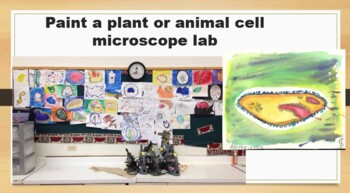Paint a plant or animal cell microscope lab
- PDF
- Easel Activity
Also included in
- Are you looking for a bundle of affordable STEM labs for your science class? This bundle has 38 files worth of field tested labs. All include materials list, worksheets, and field pictures! You can cover earth science, chemistry, biology as well as other topics with this package. The bundles coverPrice $107.28Original Price $153.25Save $45.97
- This master bundle combines genetic labs from across the full 3D-PT store! This bundle is easily a 1 semester genetics unit! Cover DNA / RNA, genotype / phenotype, evolution, and other biology topics!You can 3D print DNA & RNA, Create a creature, loose a shoe, or have other fun in the biology laPrice $30.15Original Price $33.50Save $3.35
Description
Prepare your students for an extraordinary journey into the world of cellular biology with our "Paint a Plant or Animal Cell Microscope Lab." This resource offers a unique fusion of science, art, and technology, embodying the essence of STEAM (Science, Technology, Engineering, Arts, and Mathematics) education. It invites students to explore the intricacies of plant and animal cells while unleashing their creativity.
Key highlights of the "Paint a Plant or Animal Cell Microscope Lab" as a STEAM activity include:
- STEAM Synergy: Embrace the STEAM philosophy by weaving together science, art, and technology. This lab empowers students to apply scientific knowledge while honing their artistic and technological skills.
- Cellular Discovery: Delve deep into the captivating world of plant and animal cells. Equipped with microscopes, students will embark on a scientific journey to unravel the inner workings of these fundamental units of life.
- Artistic Expression: Cultivate creativity as students transform their microscopic observations into art. They will paint or illustrate what they see under the microscope, infusing their scientific understanding with artistic flair.
- Critical Thinking and Observation: Foster critical thinking skills by challenging students to accurately identify and label cell structures. This activity sharpens their powers of observation and attention to detail.
- Technological Integration: Seamlessly integrate technology by using microscopes and digital tools to capture cell images. Students can document their discoveries digitally, adding a technological facet to the lab.
- Interdisciplinary Connections: Forge connections between cell biology, mathematics, and engineering. Explore the mathematical aspects of cell size and geometry, and discuss the engineering marvels nestled within cells, such as cellular organelles.
- Cross-Curricular Enrichment: Reinforce knowledge across various subjects, including biology, art, and mathematics. Illuminate the interplay between these disciplines and how they complement each other.
- STEAM Assessment: Assess students' understanding through their artwork, labeling precision, and explanations of cell structures. Encourage them to reflect on the artistic decisions they made in their representations.
By adopting the "Paint a Plant or Animal Cell Microscope Lab" as a STEAM activity, you'll provide students with an immersive and holistic learning experience. This resource cultivates their abilities to think critically, creatively, and analytically, bridging the gap between scientific exploration and artistic expression.
Download this innovative lab today and witness your students become emerging scientists and artists, all while deepening their reverence for the microscopic marvels that shape the living world.
Key Words: Microscope, magnification, objective, Plant Cell, animal cell, cell membrane, cell wall, chloroplast, nucleus, cytoplasim, display, paint, art, illustration, science illustration, technical drawing, watercolor.








